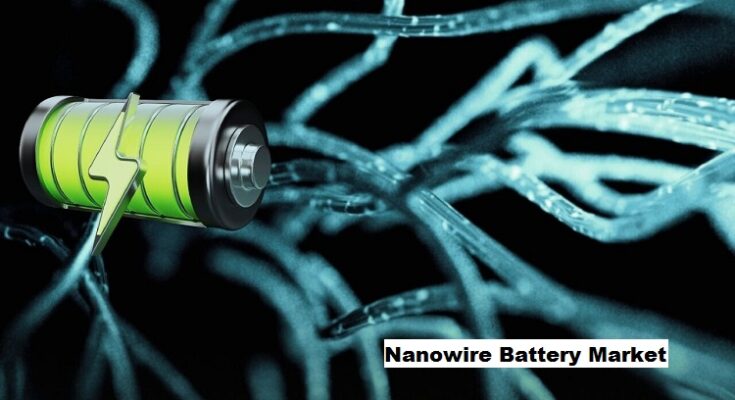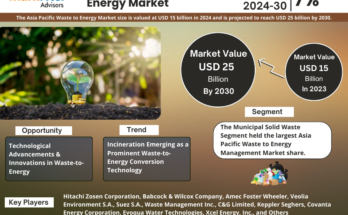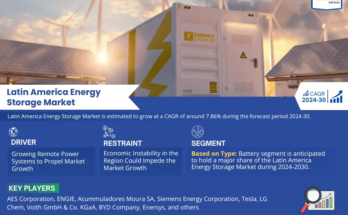Rising Demand for Electric Vehicles and Fast Charging are the factors propelling the Nanowire Battery Market growth.
According to TechSci Research report, “Global Nanowire Battery Market – Industry Size, Share, Trends, Competition Forecast & Opportunities, 2029”. Global Nanowire Battery is anticipated to project robust growth in the forecast period with a CAGR of 32.64% through 2029. Need for a longer battery lifetime and faster recharging time are the growing trends in the present battery ecosystem. Moreover, growing electric mobility and miniaturization of consumer electronics has created an urgent requirement for advanced energy storage for batteries. Nanostructured silicon has emerged as the most promising anode material owing to its high theoretical charge retention capacity of 4,200 mAh/gm, which is ten times more than traditional graphite. Such high energy density makes silicon ideal for energy-intensive applications, such as consumer electronics, electric vehicle.
Nowadays, innovations are taking place in the healthcare industry. Advanced battery-operated medical devices, such as pacemakers and hearing aids, are being designed to improve the overall health and well-being of their users. However, these implantable devices use lithium-ion batteries as power sources, which present a considerable number of safety issues to the patients. Therefore, upcoming nanowire batteries, which are lighter, safer, and have more energy density, are expected to replace lithium-ion batteries for implantable devices in the coming years.
Browse over XX market data Figures spread through XX Pages and an in-depth TOC on “ Global Nanowire Battery Market”
https://www.techsciresearch.com/report/nanowire-battery-market/21925.html
Based on Industry, Automotive is expected to hold the largest share of Nanowire Battery market for during the forecast period, Vehicles with internal combustion engine (ICE) technology were the only types preferred earlier. However, technology has now been shifting toward electric vehicles (EVs) due to growing environmental concerns. Lithium-ion batteries are predominantly used in EVs as they provide high energy density, low self-discharge, and low weight and require low maintenance.
For ICE vehicles, lead-based batteries are being widely used. These batteries are expected to continue to be the only viable mass-market battery system for the foreseeable future. For SLI applications, lithium-ion batteries require heavy cost reductions to be considered a viable mass-market alternative to lead-based batteries.
Lithium-ion battery systems propel plug-in hybrid and electric vehicles. These batteries contain the only available technology capable of meeting the OEM requirements for the vehicle’s driving range and charging time. In 2021, the global stock of electric cars reached 16.49 million units, which increased by around 9% from 10.24 million units in 2020. This growth in EVs is expected to proped the demand for lithium-ion batteries as well.
In January 2022, Nexeon Limited, a supplier of advanced silicon anode materials for next-generation lithium-ion batteries, licensed its NSP-1 technology to advanced material giant, SKC Co. Ltd. This contributed to the advancement of the research of automotive batteries.
Also, in February 2022, Panasonic Corporation announced that its Energy Company will establish a production facility at its Wakayama Factory in western Japan to manufacture large cylindrical 4680 (46 mm wide and 80 mm tall) lithium-ion batteries for electric vehicles (EVs).
Based on Region, Asia Pacific will dominate the market, Asia-Pacific has multiple growing economies with substantial natural and human resources. China and India are expected to be major investment hotspots for battery companies in the coming years because of policy-level support from the respective governments encouraging the manufacturing sector.
The deployment of electric vehicles and the installation of renewable power plants in China and India are increasing rapidly, which is expected to create a massive demand for batteries.
China is the largest market for electric vehicles (EVs), with over 1.15 million EVs sold in 2021. The country is expected to remain the world’s largest electric car market. China accounted for almost 40% of the global sales of electric cars in 2021. Additionally, in January 2022, the 50% ownership rule was relaxed for passenger cars in China. Also, the laws restricting a foreign company from establishing more than two joint ventures producing similar vehicles in the country were removed.
The Government of China is expected to cut down subsidies on electric vehicles by 30% in 2022 and eliminate it by the end of the year, as the electric vehicle industry in the country is now thriving. The planned subsidy cut is aimed at reducing the reliance of manufacturers on governmental funds for the development of new technologies and vehicles.
India is also rapidly developing advanced batteries. As part of this, in June 2022, IIT Madras researchers developed a new kind of battery technology for electric cars. They developed mechanically rechargeable zinc-air batteries, which are more economical than the existing lithium-ion batteries and have a longer shelf life. Zinc-air batteries can be used in two-wheeler and three-wheeler EVs.
Key market players in the Global Nanowire Battery Market are following: –
- Amprius
- Sila Nanotechnologies
- OneD Material
- Nexeon
- NEI Corporation
- XG Sciences
- LG Chem
- Panasonic
- Samsung SDI
- Enevate
Download Free Sample Report
https://www.techsciresearch.com/sample-report.aspx?cid=21925
Customers can also request for 10% free customization on this report.
“The global nanowire battery market is driven by several key factors that highlight the immense potential of nanowire batteries as an advanced energy storage solution. These drivers include their high energy density, enabling the storage of more energy in smaller, lighter packages. Nanowire batteries also offer fast-charging capabilities, addressing the growing demand for rapid charging in electric vehicles and portable electronics. Their longer lifespan reduces the need for frequent replacements, cutting costs and reducing waste. Safety is a critical driver, as nanowire batteries exhibit lower risks of overheating and explosions, making them safer for various applications.
Their environmentally friendly materials align with sustainability goals, reducing the environmental impact of battery production and disposal. The rising demand for electric vehicles and the need for advanced energy storage solutions in consumer electronics and IoT devices further propel the nanowire battery market. These drivers collectively position nanowire batteries as a promising technology for revolutionizing energy storage in a wide range of industries.” said Mr. Karan Chechi, Research Director with TechSci Research, a research-based global management consulting firm.
Nanowire Battery Market – Global Industry Size, Share, Trends, Opportunity, and Forecast Segmented by Material Type (Silicon, Germanium, Transition Metal Oxides, Gold), Industry (Consumer Electronics, Automotive, Aviation, Energy, Medical Devices), By Region, By Competition 2019-2029 has evaluated the future growth potential of Global Nanowire Battery Market and provides statistics and information on market structure, size, share, and future growth. The report is intended to provide cutting-edge market intelligence and help decision makers take sound investment decisions. Besides, the report also identifies and analyzes the emerging trends along with essential drivers, challenges, and opportunities present in the Global Nanowire Battery Market.
Related Reports
Saudi Arabia LNG Engine Market
https://www.techsciresearch.com/report/saudi-arabia-lng-engine-market/21276.html
Saudi Arabia Onshore Floating Solar Market
https://www.techsciresearch.com/report/saudi-arabia-onshore-floating-solar-market/21291.html
Saudi Arabia PV Cells Market
https://www.techsciresearch.com/report/saudi-arabia-pv-cells-market/4189.html
Contact
TechSci Research LLC
420 Lexington Avenue,
Suite 300, New York,
United States- 10170
M: +13322586602
Email: [email protected]
Website: https://www.techsciresearch.com




